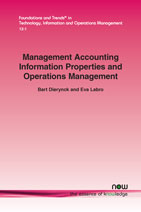Management Accounting Information Properties and Operations Management
By Bart Dierynck, Tilburg University, The Netherlands, b.dierynck@tilburguniversity.edu | Eva Labro, University of North-Carolina at Chapel Hill, Kenan-Flagler Business School, USA, Eva_Labro@unc.edu
Abstract
This monograph introduces Management Accounting to Operations Management researchers and illustrates how unleashing this accounting information perspective into the world of Operations Management can improve our understanding of topics of interest to Operations Management researchers and practitioners. We start by offering a crash course in accounting terminology and then introduce the three important properties of accounting information (i.e. imperfect nature, endogenously determined, and multipurpose). Next, we address four different areas in Operations Management: capacity acquisition and allocation, inventory management, production scheduling, and product design. For each of these areas, we describe the approaches used in Operations Management and Management Accounting and spend considerable attention on how using an accounting approach can spur progress in Operations Management.
Management Accounting Information Properties and Operations Management
Management Accounting Information Properties and Operations Management introduces management accounting to operations management researchers and illustrates how incorporating this accounting information perspective into the world of operations management can improve our understanding of topics of interest to operations management researchers and practitioners. After the introduction, Section 2 provides a crash course in the management accounting terminology on costing systems. Section 3 develops the three properties of accounting information – imperfection, endogeneity, and multi-purpose character – and provides an overview of management accounting research on these properties. Section 4 offers some excellent examples of studies on the interface between operations management and management accounting. Sections 5 to 8 explore four areas in operations management (capacity planning and allocation, inventory management, production scheduling, and product design) and provide suggestions on how the use of a management accounting perspective can generate new insights that are important for research and practice. Section 9 gives some practical advice on how to set up research projects on the interface between operations management and management accounting. The last section includes the authors’ conclusion.
